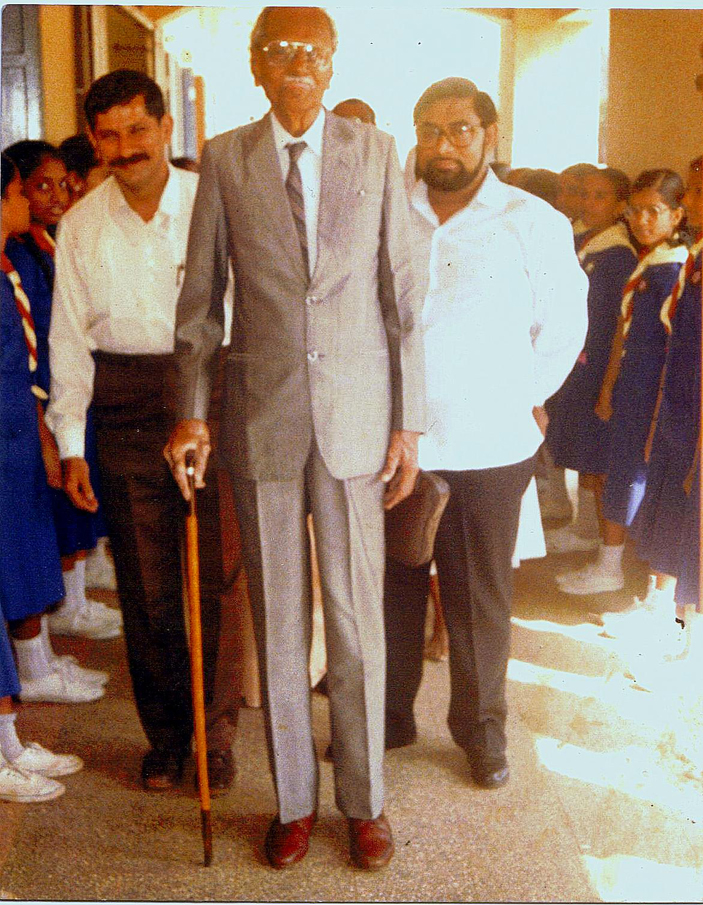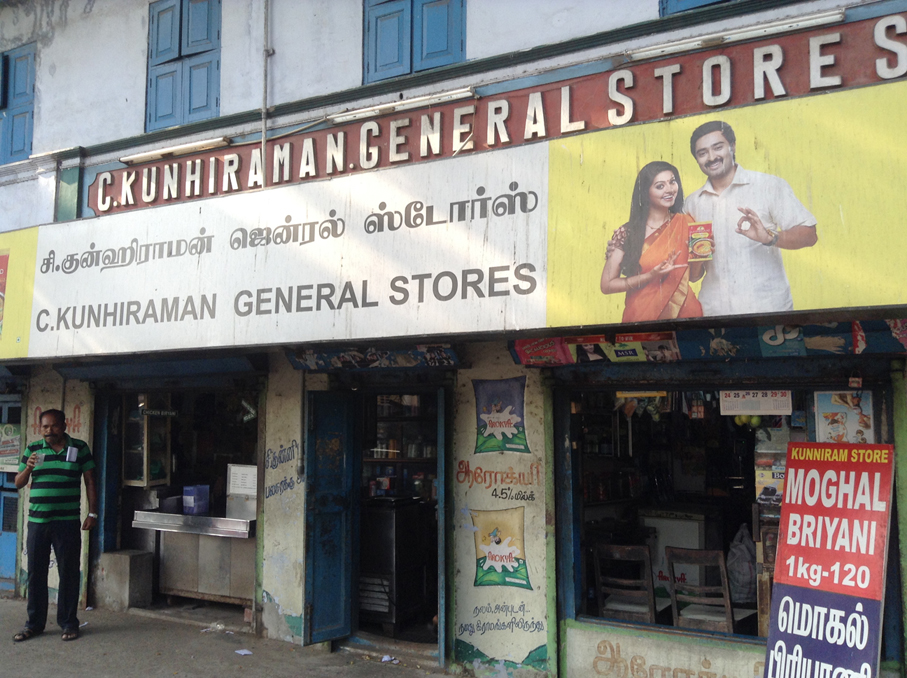Registered with the Registrar of Newspapers for India under R.N.I 53640/91
Vol. XXVIII No. 4, June 1-15, 2018
Heydays of Royapuram
Excerpted from Hari Baskaran's Those Bloomin' Anglos baskaran.hari@gmail.com

W.J. Fernandez on his 100th birthday.
it was a guided tour of the Royapuram I never knew, the Anglo-Indian quarters, but which others related nostaligically to. Maureen wistfully says, “Nine out of ten houses on the four Mada Church streets around St. Peter’s Church, Arathoon Road and P.V. Kovil Street were Anglo-Indian homes, man. All the old popular English songs, Jim Reeves, Pat Boone and all would blare out from the Radio Ceylon channel from each home.” Marie butted in with a smile, “My, it was the same song from every house.” Maureen hadn’t finished. “The smell of curries cooking was everywhere,” she said with more than a touch of glee. Cedric remembers sauntering off to play in the by-lanes with his pals. Not to be outdone, Gillean said, “After school, my cousins and I would go to our grandmother’s house on P.V. Kovil Street and play in the little compound of her house and on the street. It was time for rounders, seven-tiles and hide and seek.” There was far less traffic on the streets then and Royapuram was one big playground for the young. It was common to find groups of friends gathered at street corners engaging in the social necessity of those days, just chit-chatting.
Young children of both sexes learnt to dance almost mandatorily as this was a prime social activity for Anglo-Indians. Social events and sporting events where friends and family members gathered to cheer on their respective teams all offered platforms for the young to meet and form partnerships. Gillean said, “In the afternoons, after an enforced siesta, our grandmother would get us all together to learn dancing. The elder and better dancers would help the younger ones.”

Kunhiraman’s Stores.
From somewhere in the background we could hear a guitar strumming and voices singing a few bars of a popular song. Singing was a way of life for the Anglo-Indians. Marie said as she interrupted her humming, “My family loved music. My maternal and paternal uncles and my brothers George and Tony played the guitar, violin and piano. I have beautiful memories of my sister Ethel and me singing together from the age of five. Uncle Eugene would accompany us on the guitar or piano. We also sang at the periodic amateur nights conducted at the Parish Hall.”
Marie added, humming and smiling at the same time, “In the mid-1960s, mid-70s my two childhood friends, Philo Scurville, May Noronha, and I formed a singing group called ‘The Cascades’ and we were invited to sing at most Anglo-Indian functions all over Chennai.”
There was much of the life of old Royapuram that I had let slip by but I can never forget the Sunday evenings at the Mater Dolorosa Parish club where 16mm movies would be screened on the premises of the church. We got to see some very good movies and enjoyed them very much. The tickets for these shows were four annas to sit on the ground and watch and eight annas to sit on a chair but you had to bring your own chair. “Remember the movies at Mata Dolorosa Church?” I asked the group, “Oh yes,” they said unison. Cedric chipped in, “The projector used to be operated by Rudy Watts, who had strict instructions from the priests to block off kissing scenes with the help of a small cardboard piece that blanked the screen during these “objectionable” scenes. He was popularly called Cardboard Watts.
The Mater Dolorosa Parish club was a beehive of activities; something I observed from afar in those days. Whist drives, tombola, dance sessions, amateur music festivals and much more took place at regular intervals. Desmond Hold said, “MC D’Souza, who was for over a decade the secretary of the club, was instrumental in keeping the club active. Picnics to Mahabalipuram, Kovalam beach and Ennore among other places of interest were popular and well-attended activities.”
You always associated the church with social activity, though memories linger of Anglo-Indian friends setting off for church on Sunday mornings dressed, as they say, in their Sunday best. The church would overflow and many people could be standing around outside. The choir represented the best of singing talent in the days leading up to Christmas.
At Christmas time, “It was so much fun as the carol singers went from house to house in a gaily decked and petromax-lit open bus singing carols,” said Gillean. Marie recollects, “Bleary-eyed folks would switch on their house lights to acknowledge our group and hand over envelopes with donations which were used to buy clothes and provide Christmas lunches for the less privileged families.”
Maureen Nash talks fondly about Christmas time when dhol dhols, cookies and cakes were made. She said, “The dhol dhols required the entire family to help as it was difficult to stir and cooking on the wood fires also took ages. My mother cooked roast turkey and the thick gravy that was made from the extras. She ran the Bishop Corrie school’s canteen for over a decade in the 1960s and 70s and definitely knows a thing or two about cooking.” Christmas time was when every family eagerly awaited plum cakes laced with rum, kulkuls and homemade red wine from our Anglo-Indian friends.
Cedric and Marie said almost together, “The Band Wagon, organised by the Anglo-Indian Association, was the highlight of the Christmas parade with Anglo-Indians and non-Anglo-Indians joining in the festivities.” Desmond Holt added, “Participating families handed over their presents to the organisers to be distributed by ‘Santa,’ a local or a visiting expatriate, as the parade went around the streets of Mada Church from house to house much to the enthusiasm and excitement of the young and old alike.” He added, “a bullock cart was hired and decked up for the occasion along with a marching band from the local police force.” There was always an organiser or two and when they emigrated, there was always someone to take their place.
Marie recalls, “One year they organised a Christmas pageant. Mada Church Street was blocked at both ends (with police protection) for the entire evening and was transformed into a magical fairyland; a carnival where Santa slid down a rope from one of the rooftops. There were carollers, Christmas music from loudspeakers, food stalls, laughter, singing, and dancing. The entire street was illuminated with Christmas lights and decorations, with excited kids running freely all over the place without any fear of being knocked over by motor vehicles. It was open to everyone.”
Not to be outdone, the young brigade added immensely to the Xmas gaiety. They improvised on old hymns and made up new hymns to the beat of pop music (‘Beat Masses’, as they were called), which attracted a huge crowd for Sunday Masses. They formed the youth band, ‘The Winds of Harmony,’ and sang for many Royapuram weddings. Sharon Sharman wistfully says, “Those were the best fun times we had till most of the crowd either moved to Australia or out of Royapuram.”
Theresa Waples, the senior person who shuffled along with the group as we walked along the old haunts of Royapuram, stopped the group by the old railway station and said with a touch of gravity, “The Anglo-Indian colony in Royapuram originated around the railway station like most other Anglo-Indian colonies across the country. The Railway Institute club was home to many Anglo-Indian jam sessions and other social events.” She also recalled the merry-go-rounds and food stalls that would come up along South Mada Church Street during Easter. Everyone would go around greeting each other and “If you miss meeting anyone they would tell your mother and you would get a good kicking.”
No narrative of Royapuram can neglect the role that W.J. Fernandez played for decades as he encouraged the less privileged of the community to complete their education and to study beyond high school. WJ was a philanthropist at heart and initiated several measures to raise funds to support the education of needy children. Errol and Cedric were active members of the group that helped WJ in these fund-raising activities. Bunny Peters said, “WJ was also the secretary of the St. Mary’s Old Boys Association, which unfortunately split from the official alumni association of the school on what might have been differences of opinion with Rev. Father Whyte and some of the teaching staff of the school.”
It was inevitable that a group filled with nostalgia would stop by at the Kunhiraman’s corner shop, a popular meeting place for all the little groups, hanging around and talking as they ordered mango ice cream or grape juice or fresh lime soda. Kunhiraman’s store is an institution that time has left unchanged over the last 50 years or so. It was amazing to see that the shop had not changed one bit. We all ordered grape juice and mango ice cream; both tasted just the same as it did years ago. Bobby ordered tiny samosas which everyone gobbled up. Kunhiraman’s store lives on.
Persian Bakery was another institution of the day. Errol fondly remembered, “Gajapathy, who spoke English with distinctive Anglo-Indian slang and bits of Tamil thrown in, was the popular owner. Persian Bakery made excellent wedding cakes that were popular all across Chennai among the community.” Royapuram was blessed with two excellent bakeries, the second being Royapuram Bakery on East Mada Church Street. Errol adds, “Royapuram Bakery was run by Moorthy and their wedding cakes too were the talk of the town, with people coming from as far away as Arakonam, man, to buy cakes.” Royapuram Bakery also offered the additional service of baking homemade cakes and also roasting turkeys during Christmas times.
We meandered towards Ideal Stores where we would once go to pick up gifts and knick-knacks from time to time. Who can forget the barber shop on West Mada Church Street? That nondescript place where all of us went for our haircuts; nothing fancy like the salons of today. It was another world.
(To be continued)


Comments